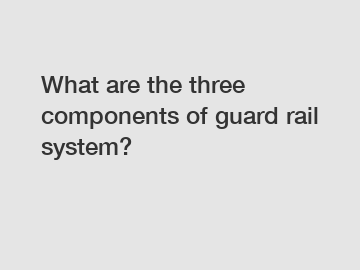What are the three components of guard rail system?
Guardrails play a crucial role in ensuring safety on roads, highways, and other elevated structures. They provide a protective barrier that helps prevent vehicles from veering off the road and potentially causing accidents or damage. Guardrail systems consist of several components that work together to create an effective safety barrier. In this article, we will explore the three primary components of a guardrail system and understand their functions.
1. W-Beam Guardrails.
The first component of a guardrail system is the W-beam guardrail. This type of guardrail is made up of corrugated steel sheets formed into the shape of a W. The W-beam guardrails are sturdy and can withstand the impact of a vehicle.

The main function of the W-beam guardrail is to redirect vehicles back onto the road or prevent them from crossing over into oncoming traffic or a hazardous area. In the event of a crash, the guardrail absorbs the impact and helps to reduce the severity of the collision. W-beam guardrails are highly effective in protecting drivers, passengers, and pedestrians from accidents that could result in injury or even death.
2. Posts and Hardware.
The second vital component of a guardrail system is the posts and hardware. These components provide the structural support and attachment points for the W-beam guardrails. The posts are typically made of metal or wood, and they are installed at regular intervals along the guardrail. The spacing between the posts ensures that enough support is provided to the guardrail and prevents it from sagging or collapsing.
The choice of hardware is crucial in ensuring the guardrail system's effectiveness and durability. The hardware includes bolts, nuts, washers, and other fasteners that secure the guardrail elements together. These hardware components must be robust enough to withstand the forces exerted during a crash while maintaining the overall integrity of the guardrail system.
3. End Treatments.
The third component of a guardrail system is the end treatments. End treatments act as a transition between the guardrail and its termination point, such as a bridge abutment or another solid structure. These treatments are essential to minimize the potential hazards associated with impacting the end of the guardrail.
There are various types of end treatments available, including terminal ends, energy-absorbing end treatments, and crash cushions. Terminal ends are designed to cap the ends of the guardrail, preventing it from becoming a hazard itself. Energy-absorbing end treatments are specifically engineered to absorb the impact energy during a collision and redirect the vehicle away from the hazard. Crash cushions offer increased protection by reducing the impact forces experienced by the occupants.
Conclusion.
Guardrail systems are critical elements of road safety infrastructure, providing protection and reducing the risk of severe accidents. Understanding the key components of a guardrail system helps us appreciate their purpose and importance in maintaining road safety.
The three primary components of a guardrail system, namely W-beam guardrails, posts and hardware, and end treatments, work collectively to ensure the effectiveness of the safety barrier. Each component has a specific function, from redirecting vehicles back onto the road to absorbing impact forces during a collision.
If you require more information or assistance regarding guardrail systems installation, maintenance, or safety guidelines, please do not hesitate to contact us. Road safety is a shared responsibility, and together, we can create safer roads for everyone.
Contact Us.
Are you interested in learning more about Traffic Guardrails Manufacturer , Traffic Guardrails Manufacturer, w beam highway guardrail? Contact us today to secure an expert consultation!
263
0
0

Comments
All Comments (0)